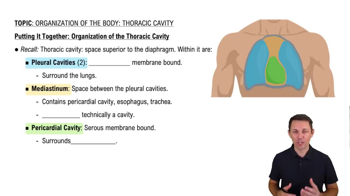Here are the essential concepts you must grasp in order to answer the question correctly.
Anatomical Position
The anatomical position is a standardized way of observing the body, where the individual stands upright, facing forward, with arms at the sides and palms facing forward. This position serves as a reference point for describing the location of body parts and their relationships to one another, ensuring clarity in anatomical terminology.
Recommended video:
Mediastinum
The mediastinum is the central compartment of the thoracic cavity, located between the lungs. It contains vital structures, including the heart, major blood vessels, trachea, and esophagus. Understanding the mediastinum's boundaries helps in locating the heart, which is situated slightly left of the midline, within this compartment.
Recommended video:
Organization of the Thoracic Cavity
Cardiac Orientation
Cardiac orientation refers to the specific positioning of the heart within the thoracic cavity. The heart is tilted slightly to the left, with its apex pointing downward and to the left, while the base is oriented upward and posteriorly. This orientation is crucial for understanding the heart's relationship with surrounding structures and its functional dynamics.
Recommended video:
Events in the Cardiac Cycle
 Elaine N. Marieb, Katja Hoehn 7th Edition
Elaine N. Marieb, Katja Hoehn 7th Edition Ch. 1 The Human Body: An Orientation
Ch. 1 The Human Body: An Orientation Problem 9
Problem 9 Verified step by step guidance
Verified step by step guidance


